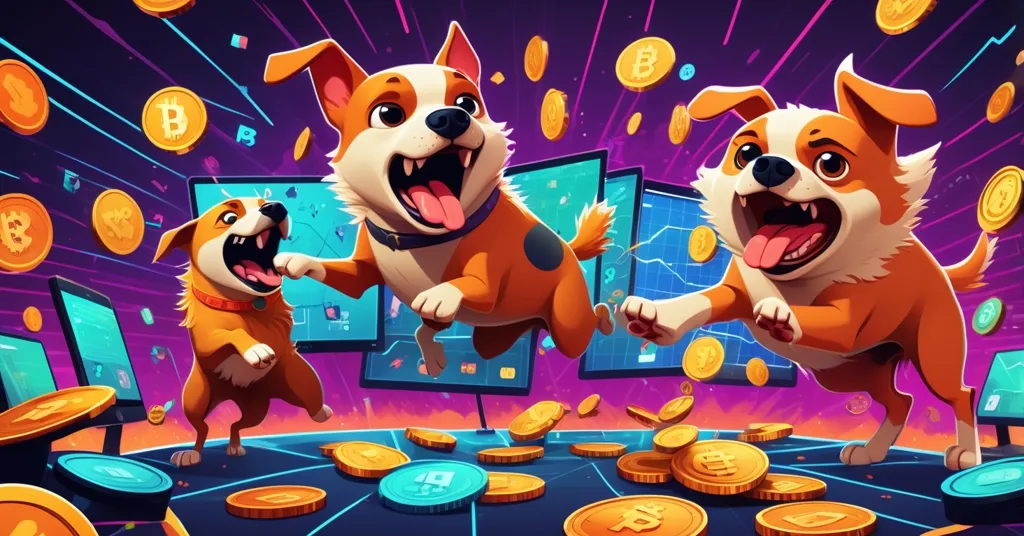Pepe vs. Shiba Inu: Is a Meme Coin Flippening on the Horizon?

PEPE Price Prediction: Is This the Meme Coin Flippening with SHIB Everyone’s Been Waiting For?
Pepe (PEPE) is hopping its way into the spotlight, stealing social media thunder from Shiba Inu (SHIB) and igniting debates about a potential “flippening” in the meme coin ranks. As the third-largest meme coin by market cap, Pepe’s recent buzz has traders speculating whether it can leapfrog SHIB, but beneath the memes and hype lies a volatile swamp of risk and uncertainty. Let’s break down the frog frenzy.
- Social Media Surge: Pepe commands 2.9% social dominance per LunarCrush, nearly double SHIB’s 1.7%.
- Price Rollercoaster: After a 30% drop, Pepe could rally up to 300% if support levels hold.
- Ecosystem Play: Pepenode ($PEPENODE) emerges with a mine-to-earn game tied to Pepe’s hype.
What Are Meme Coins, and Why Do They Matter?
For the uninitiated, meme coins are a quirky corner of the cryptocurrency market, often born from internet jokes or viral culture rather than any deep technological innovation. Think of them as digital collectibles fueled by community hype—tokens like Dogecoin (DOGE) paved the way, turning a Shiba Inu dog meme into billions in market value with a nudge from influencers like Elon Musk. Unlike Bitcoin, which pushes for financial sovereignty and decentralization, or Ethereum, which underpins a vast network of decentralized finance (DeFi) apps, meme coins are mostly speculative. They draw in retail investors with low entry costs and the promise of moonshot gains, but they’re also a lightning rod for scams and market manipulation. So why care? Because meme coins, for better or worse, onboard millions to crypto, even if they often leave newbies burned when the hype fades.
Pepe’s Social Media Takeover: Hype or Harbinger?
Pepe, inspired by the internet’s infamous frog meme, is making serious noise online. Data from LunarCrush, a platform that tracks crypto sentiment across social media, pegs Pepe’s social dominance at 2.9%. That means nearly 3% of all crypto-related chatter—tweets, Reddit posts, and TikTok rants—is about this green mascot. By contrast, Shiba Inu, a longtime meme coin heavyweight, lags at 1.7%. Social dominance isn’t just a vanity metric; it often signals where retail attention and money might flow next. When the internet obsesses over a token, buying pressure can follow as FOMO (fear of missing out) kicks in. Pepe’s frog army is hopping mad on platforms like Twitter, but does this mean it’s poised to overtake SHIB?
Let’s unpack what “social dominance” really measures. LunarCrush analyzes mentions, engagements, and overall buzz across major platforms to gauge a coin’s mindshare. A higher score suggests more people are talking about Pepe, sharing memes, or debating its potential. But there’s a catch—social metrics can be gamed. Bots, paid promotions, or coordinated hype campaigns can inflate numbers, making them less reliable than raw market data. While Pepe’s lead over SHIB looks impressive, it’s worth questioning whether this reflects genuine community interest or just a well-orchestrated noise machine. Still, in the meme coin jungle, perception often trumps reality, at least in the short term.
SHIB vs. Pepe: A Market Cap Reality Check
Despite the social media gap, Shiba Inu holds a stronger position where it counts—market capitalization. Market cap is the total value of a coin’s circulating supply, calculated by multiplying the current price by the number of tokens out there. SHIB remains ahead of Pepe, sitting as the second-largest meme coin behind Dogecoin, while Pepe trails in third. SHIB also has a more established ecosystem, including Shibarium, a layer-2 scaling solution designed to make transactions faster and cheaper on its network. It’s a small step toward utility, giving SHIB a veneer of legitimacy that Pepe, still mostly a cultural fad, lacks.
So, could a “flippening”—a term borrowed from Ethereum’s long-shot bid to surpass Bitcoin in market cap—happen between Pepe and SHIB? It’s not impossible. If social buzz translates into sustained buying, Pepe could close the gap. But SHIB’s larger community, longer track record, and infrastructure make it a tough target. Meme coin history tells us flips are rare without a massive catalyst—think Dogecoin’s epic 2021 run after Musk’s tweets. Without a similar push, Pepe’s climb looks like a steep one. Crypto Twitter might be hyping a showdown, but market realities don’t bend so easily to memes.
Pepe Price Analysis: Boom or Bust?
Now let’s talk numbers, because hype doesn’t pay the bills—price does. Pepe has had a rough week, shedding nearly 30% of its value in just seven days, hovering near a critical support level of $0.0000060. For those new to trading lingo, a support level is a price point where buyers tend to step in, preventing further drops. It’s like a floor that the market historically respects, at least until it doesn’t. If Pepe holds this line, some traders see a bounce to $0.000011 on the horizon, an 83% jump from current levels. The most starry-eyed are even dreaming of a return to December highs, which could mean a 300% rally.
Adding to the optimism is a technical tool called the Relative Strength Index (RSI), which measures whether a coin is overbought (too many buyers, price likely to fall) or oversold (too many sellers, price might rebound). Think of it as a rubber band—stretch it too far in one direction, and it often snaps back. Pepe’s RSI is dipping into oversold territory, hinting at a potential reversal. But let’s cut the crap—meme coin price predictions are a shot in the dark. A 300% gain sounds sexy, but anyone claiming to know where a token like Pepe is headed with certainty is either lying or delusional. These markets are a casino, not a crystal ball. Historical crashes, like SafeMoon’s implosion after hype-fueled pumps, remind us that meme coins can evaporate as fast as they spike. If that support breaks, Pepe could sink deeper into the mud, and no amount of Twitter memes will save it. For more insights on the potential trajectory, check out this detailed analysis of Pepe’s price trends.
Pepenode: Innovation or Just Another Gimmick?
While Pepe’s price action keeps traders guessing, a new project is trying to ride the frog’s cultural wave. Enter Pepenode ($PEPENODE), a mine-to-earn (M2E) game that’s tapping into the play-to-earn trend popularized by projects like Axie Infinity. Unlike traditional crypto mining, which demands pricey hardware and guzzles electricity, Pepenode offers a virtual alternative. Players invest $PEPENODE tokens to set up digital mining rigs, upgrade their setups, and earn rewards, including airdrops of popular meme coins like Bonk ($BONK) and even SHIB. It’s a gamified twist on earning crypto, blending meme culture with browser-based fun.
Pepenode also introduces token economics to potentially boost value. About 70% of $PEPENODE tokens spent on in-game upgrades are burned, meaning they’re permanently removed from circulation. Think of it like limited-edition sneakers—fewer in existence can drive up value if demand holds. The project claims to have anti-bot measures to keep things fair, stopping automated scripts from gaming the system and screwing over real players. Sounds promising, right? Well, pump the brakes. New projects in the meme coin space are often a crapshoot. Many promise revolutionary mechanics only to collapse under sell pressure or outright scams. Pepenode’s sustainability hinges on attracting a steady player base and balancing rewards with burns—too many tokens flooding the market from airdrops could tank the price, burn or no burn. Compared to Axie Infinity, which struggled with token inflation despite early success, Pepenode’s model raises red flags. Is it a clever addition to Pepe’s ecosystem or just speculative fluff? I’d wager on caution—don’t get rekt chasing frog dreams on unproven concepts.
Meme Coins in the Bigger Crypto Picture
Stepping back, the obsession with social metrics and meme coin rankings reveals the chaotic nature of this niche. Unlike Bitcoin, which stands as a beacon of sound money and decentralization, or Ethereum, which powers smart contracts and DeFi innovation, meme coins are largely a cultural sideshow. Their value often comes from viral memes, influencer shills, and retail FOMO rather than any tangible utility. Tools like LunarCrush are critical for tracking where the crowd’s attention shifts, because in this game, attention equals buying power—until it doesn’t. But let’s not sugarcoat it: this space is also a petri dish for scams, pump-and-dumps, and heartbreak for investors who bet the farm on a 100x moonshot.
From a Bitcoin maximalist lens, meme coins are digital hot air—fun for a laugh but a distraction from crypto’s true mission of disrupting centralized finance and empowering individuals with privacy and freedom. Yet, there’s a flip side. Meme coins democratize access to crypto, letting the little guy play in a market often dominated by whales and institutions. They’re a middle finger to Wall Street, even if they risk tainting crypto’s reputation with volatility and fraud. If regulators crack down after the next big crash—and history says they might—meme coins could become crypto’s Achilles’ heel. Still, their role in onboarding new users can’t be ignored. Every DOGE buyer today might be a Bitcoin hodler tomorrow, assuming they don’t get wiped out first.
What’s Next for Pepe and the Meme Coin Craze?
Looking ahead, Pepe’s trajectory depends on a few wild cards. Major exchange listings, community-driven events, or a celebrity endorsement could spark another rally, much like Musk’s tweets did for Dogecoin. But without fundamentals, any spike is likely a mirage. SHIB, for all its fading buzz, still has staying power with projects like Shibarium. And Pepenode? It’s a neat experiment, but untested projects in this niche are a dime a dozen—most fade into obscurity within months. Beyond individual tokens, the meme coin craze itself faces headwinds. Regulatory scrutiny is tightening globally, and a high-profile scam or crash could trigger harsher rules, spooking retail investors. On the flip side, if mainstream adoption grows, meme coins might evolve into something more than internet jokes—though I wouldn’t bet on it just yet.
Key Takeaways and Questions
- What’s fueling Pepe’s social dominance over Shiba Inu?
LunarCrush data reveals Pepe captures 2.9% of crypto conversations versus SHIB’s 1.7%, likely driven by viral memes and fresh community excitement on platforms like Twitter. - Can Pepe overtake SHIB in market cap for a real flippening?
It’s a long shot without a major catalyst; SHIB’s larger market cap and ecosystem (like Shibarium) give it an edge, even if Pepe wins the social media war for now. - What risks come with investing in Pepe right now?
A recent 30% price drop underscores meme coins’ brutal volatility; with no real utility, Pepe is vulnerable to pump-and-dump schemes and sudden crashes if support levels fail. - How does Pepenode’s mine-to-earn model tie into Pepe’s ecosystem?
Pepenode lets players invest $PEPENODE for virtual mining rigs to earn meme coin rewards, capitalizing on Pepe’s hype with token burns (70% of spent tokens) to potentially increase scarcity. - Are social media metrics a trustworthy gauge for meme coin potential?
They’re a useful snapshot of community interest and often predict short-term price moves, but bot activity and paid hype can distort data, making them far from foolproof. - Do meme coins like Pepe align with crypto’s broader goals?
Partially—they onboard new users and challenge traditional finance with chaotic energy, but their speculative nature and scam risks clash with Bitcoin’s mission of sound money and decentralization.
Pepe’s rise, SHIB’s quiet struggle, and quirky sideshows like Pepenode paint a vivid picture of the meme coin madness—equal parts thrilling and infuriating. Social buzz might push Pepe toward a breakout, and technicals hint at a rebound if key levels hold. But let’s not kid ourselves: this is a speculative minefield where gains are as fleeting as internet trends. Meme coins are a loud, messy rebellion against the financial status quo, and while that resonates with the spirit of decentralization, they’re also a gamble that can burn the unwary. Stay sharp, do your homework, and don’t fall for the hype machine. We’ll keep cutting through the noise with unfiltered takes on this crypto circus.



